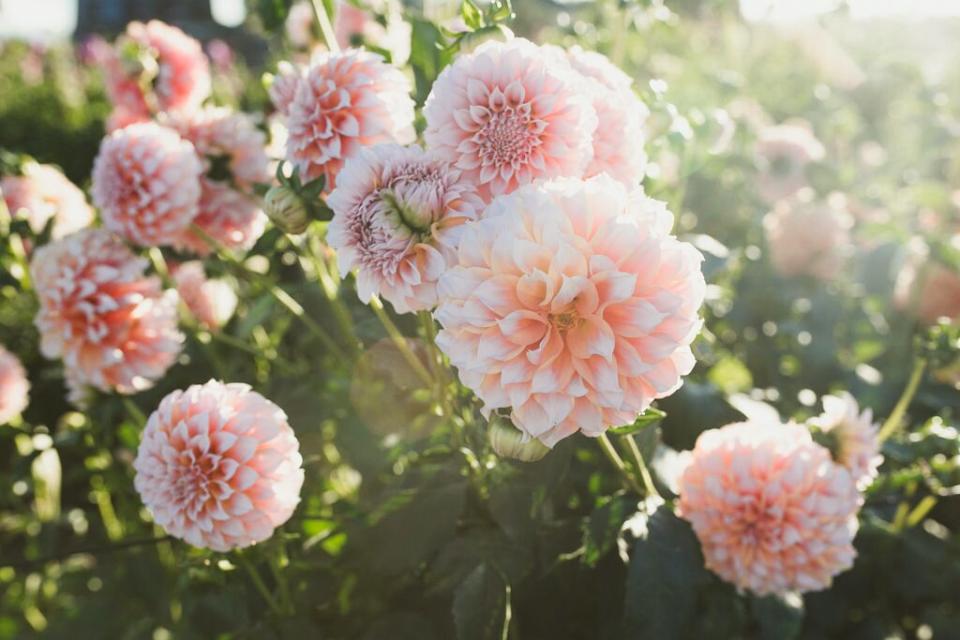Plant These Flower Bulbs, Corms, and Tubers in the Spring and Look Forward to Tons of Late Summer Blooms
Typically, most bulbs you plant in your home garden (including favorites like tulips, daffodils, and crocus flowers) need to be placed in the soil before the first frost in order to guarantee blooms by spring. If you missed the planting window, there are still a number of bulbs (and those that are associated with bulbs, such as tubers, corms, and tuberous roots) to plant in the spring that will yield late summer flowers.
These plants don't need the extended cold dormancy period to grow like fall-planted bulbs, which means you can plant them in the spring and still enjoy them before the end of the year. Choose from one (or a few!) of these bulbs this spring, then watch as they add a touch of color to your summer landscape.

Michelle Westling Photography
Related: The Most Popular Flowering Bulbs to Plant in Your Garden
Dahlias
Dahlias are prolific blooms that come in a dazzling range of flower sizes, forms, and petal colors, according to Debra Prinzing, founder and creative director of the Slow Flowers Society. "In the border, they appear lush and abundant," she says. "As a cut flower, they practically arrange themselves." You can add some to your garden by planting the potato-like tubers in full sun. "Give your dahlias a jump-start and prepare soil by adding compost and an all-purpose (5-5-5) granular fertilizer." Though dahlias are only winter-hardy in USDA hardiness zones eight to 11, Prinzing says gardeners in zones three to seven can grow the flower each season, digging up the tubers at the end of the season, overwintering them inside their homes, then planting again the following year.
Gladiolas
A favorite flower among gardeners, gladiolas are enjoying a renaissance in the cutting garden, especially with soft-hued varieties like pale green and apricot, explains Prinzing. "Plant the small, round corms in spring and wait for their three-foot spikes to emerge, covered with orchid-shaped blooms," she says. "Gladiolas grow best in fertile, well-drained soil with consistent moisture." The corms should be planted with the pointed side facing up and a little deeper than the recommended three- or four-inch depth to help keep the stems upright once the flowers begin to open. "Gladiolas are winter hardy in zones seven to 10," she says, but they can be grown as annuals in colder climates.
Lilies
Lilies are hardy bulbs that can add drama to your garden. "Their blooms demand attention and come in a wide array of petal colors, both solid and flecked," explains Prinzing. "Plant a combination of lily varieties to enjoy a mixed display—Asiatic, double Asiatic, LA Hybrid, Trumpet, Oriental, and OT Hybrid forms." Doing this can insure a long summer full of a variety of blooms. "Lilies are perennials and will survive the winter outdoors in USDA zones four to nine."
Calla Lilies
Known for their unique, curvaceous flower, calla lilies bloom in classic white, yellow, orange, pink, rose, lavender, and dark purple-plum, according to Prinzing. "Plant them in full sun or partial shade; in cooler areas, they prefer full sun," she says. "Group them in clusters at the front of a border or plant them in containers." These beautiful flowers can only be grown as annuals in USDA hardiness zones eight to 10, everywhere else they'll have to be grown as an annual.
Chocolate Cosmos
Unlike a true cosmos, which is typically grown from seed as an annual, this flower is grown from a small bulb. "It produces velvety, burgundy-maroon blooms that resemble a single cosmos flower on a tall, dark stem," says Prinzing. As an added bonus, these flowers have an irresistible cocoa-like fragrance. "These are heat-lovers originally from Mexico and they love warmth and sun," something she says makes them great for container planting. These flowers are winter hardy in USDA zones seven through 11.
Related: Six Gorgeous Summer Container Gardening Ideas
Acidanthera Murielae
Also known as a "peacock orchid," Prinzing says this fragrant, summer-blooming relative of the gladiola produces graceful white flowers on slender stems. "There is a distinctive, dark-purple mark at the throat of each nodding flower—a pretty contrast." These plants should be grown in full sun and planted after the soil has begun to warm. "Winter hardy to zones six to 10, Acidanthera can be grown as an annual in cooler or warmer zones."
Caladium
These bulbs feature showy leaves rather than blooms, says Kacey Ziegler, senior event design manager at B Floral. "They are a little more versatile for placement since they thrive in bright, indirect light, meaning they can be dappled right under other plants or placed where their leaves can see the sky but are not in direct sunlight." Caladiums come in a variety of colors, including a stunning white and green combination, pinks, reds and magentas. "Caladiums can also be moved inside over winter to give your space life as a colorful houseplant."
Allium Gigateum
If you're looking to make a gigantic impression in the garden, David J. Kiss, MLA, horticulturalist, landscape theorist, and author of Designing Outside the Box ($24.99, amazon.com), says you should look no further than Allium gigateum, which is also known as ornamental onion. "A living lollipop at a mature height of three- to five-feet crowned with a perfectly round 9-inch flower globe of violet mellowing to lilac-pink," he says. "Plant in clusters for an Alice in Wonderland 'wow' factor."
Canna Lily
If you want to add height and dimension to your garden, Kiss suggests adding a Canna Lilly, which can grow to five- to seven-feet in height and come in a variety of saturated flower colors and bold leaf patterns. "It's tropical appearance summers well at the pool side and backyard terrace."

